Victron Cerbo GX, good AC/DC power monitoring gets better
The existing Victron Venus GX and Color Control GX are both excellent AC/DC power monitoring products in my estimation, but with many boat systems it’s hard to decide which one to use. While the Venus blue box is less expensive with more networking capabilities, none of its display and control abilities are as fast and easy as the CCGX’s screen and button interface. I’m happy to report that this purchasing dilemma will end next year with the new Cerbo GX and GX Touch 50, and valuable additional GX features are included.
To put it another way, when the Venus-like Cerbo GX ships in February (“expected”) at a Venus-like retail price of $381, you’ll also be able to purchase a $287 GX Touch 50 for what looks like a direct color display even nicer than the CCGX. Moreover, existing GX products already have more display options than they did last year, and more to come.
A good resource for understanding the Cerbo evolution is the Victron GX product range page. And if you’re not familiar with what a GX device can do, you might appreciate my first Venus GX testing entry last winter, and then what I saw as the MFD glass bridge integration feature underwent beta testing. (MFD integration is now an official feature, Raymarine just joined Garmin and Navico, and I was delighted to spot a Furuno engineer discussing it with Victron at METS.)
Meanwhile, I believe that the NMEA 2000 integration feature highlighted in the Cerbo introduction photo at top is just coming out of Beta testing (a little later than planned) and I hope to try it with the Venus GX soon. But while I can picture how the MFD integration, N2K output, or a dedicated GX display could be useful on a boat like mine — actually, there are good reasons to want them all — just using the Venus GX via WiFi and Ethernet has been quite satisfactory on and off the boat.
In fact, the detailed battery, inverter/charger, and solar panel data that Venus logs to the free Victron Remote Monitoring (VRM) service has vastly expanded my understanding of electron life on Gizmo. Individual loads aren’t identified, and neither is alternator output, but highly detailed voltage/shunt current graphing and other data can show you a lot about, say, the power cost of refrigeration or the performance of a smart regulator (and an odd recent example was checking out the power needs of my DIY hookah compressor).
You can see much of Gizmo’s VRM site yourself, though I suggest using the many date filtering options (and the Advanced section) to look into the April through October season. The boat is now without solar power, and often offline, in steel building at Journey’s End Marina where I am redoing most of the electronics. A test Cerbo GX will hopefully be a key aspect of the new scheme, and let’s look at the details.
While Victron’s new Cerbo GX page doesn’t include a datasheet yet, the aforementioned GX range page does enumerate the profusion of connection ports. Note, for instance, the increase in tank level and temperature sensing inputs compared with Venus. (Though so far the implementation and configuration of these extra beyond-power monitoring features seem hard to figure out, or perhaps underdeveloped, I remain hopeful. And, then again, my Venus GX can already make good monitoring use of an inexpensive USB GPS.)
Note too the BMS-Can port with support for many third-party battery systems. And to see how GX can scale up to a very large boat, or an off-grid eco-village in Corsica, check out this recent Victron Blog entry. Which makes this a good spot to note that the VRM cloud service — which can also be used to configure, update, and troubleshoot many Victron devices — means that a boat owner cowed by GX complexity can have a professional installer with powerful remote access.
And a big deal for both professional and DIY installers is that Cerbo is the first GX product with a “Smart” Bluetooth connection. So a Cerbo can be directly configured using the Victron Connect app I raved about here. In other words, while you can still use one of the several (somewhat tricky) initial Venus GX setup methods, instead you will be able to pull out your phone, have Victron Connect pair with your Cerbo automatically, and then walk you through the initial configuration.
I didn’t get to try the GX Touch 50 at METS but I’m very familiar with that animated and informative main screen, and how a user can drill down to further power detail (and many settings). And I imagine that besides looking good in this flat glass 5-inch format, the interface will be quite responsive with its HDMI connection to the Cerbo GX, which itself has more processor and memory than the Venus.
I also like the thin waterproof design, which is about 5 x 3.5 x 1/2 inches including the fixing bracket that permits surface mount with only a small hole in the underlying panel. Wouldn’t it be nice if a navigation electronics manufacturer developed a similar NMEA 2000 instrument display, especially if it too cost less than $300 retail?
Victron managing director Matthijs Vader — who is personally quite instrumental in GX development — says their strategy is to make the monitoring options flexible and affordable because it helps to sell other Victron devices. And given my GX experience on Gizmo, and having been inside the big and busy Victron U.S. distribution warehouse here in Maine, I believe the strategy is working.
This SmartShunt was also shown at METS though so far it’s only been mentioned online in a Victron Blog show preview entry. So the timing of confirmed product details and actual sales is currently uncertain. But I did gather that the SmartShunt is essentially a BMV-712 Smart battery monitor without the display or buttons. Which means even more elegant installs will be possible, with just Touch 50, glass bridge, N2K, and/or mobile app interfaces visible on a boat. Cool!
In fact, Ben Stein and I saw several other innovative AC/DC power monitoring developments at METS — from brands like MasterVolt, CZone, and Carling Technologies (Maretron) — and you’ll be hearing about them. I may be a little overfocused on this area personally, because my boat rarely has shore power, but isn’t it true that as marine navigation, communications, and comfort systems mature, the remaining mystery on many vessels is the mess of AC and DC components that power all the goodies? Are you well informed about electron life on your boat?


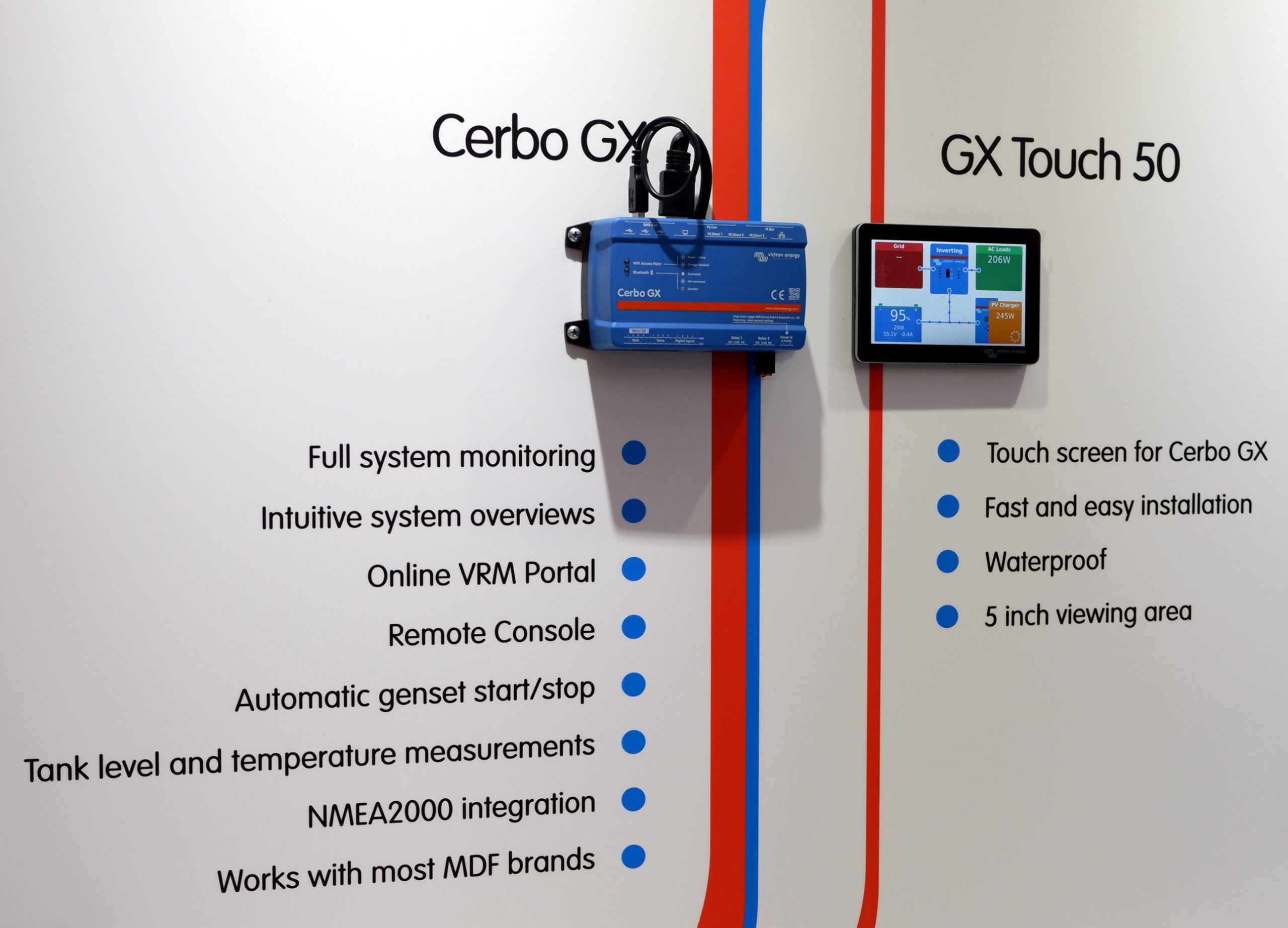
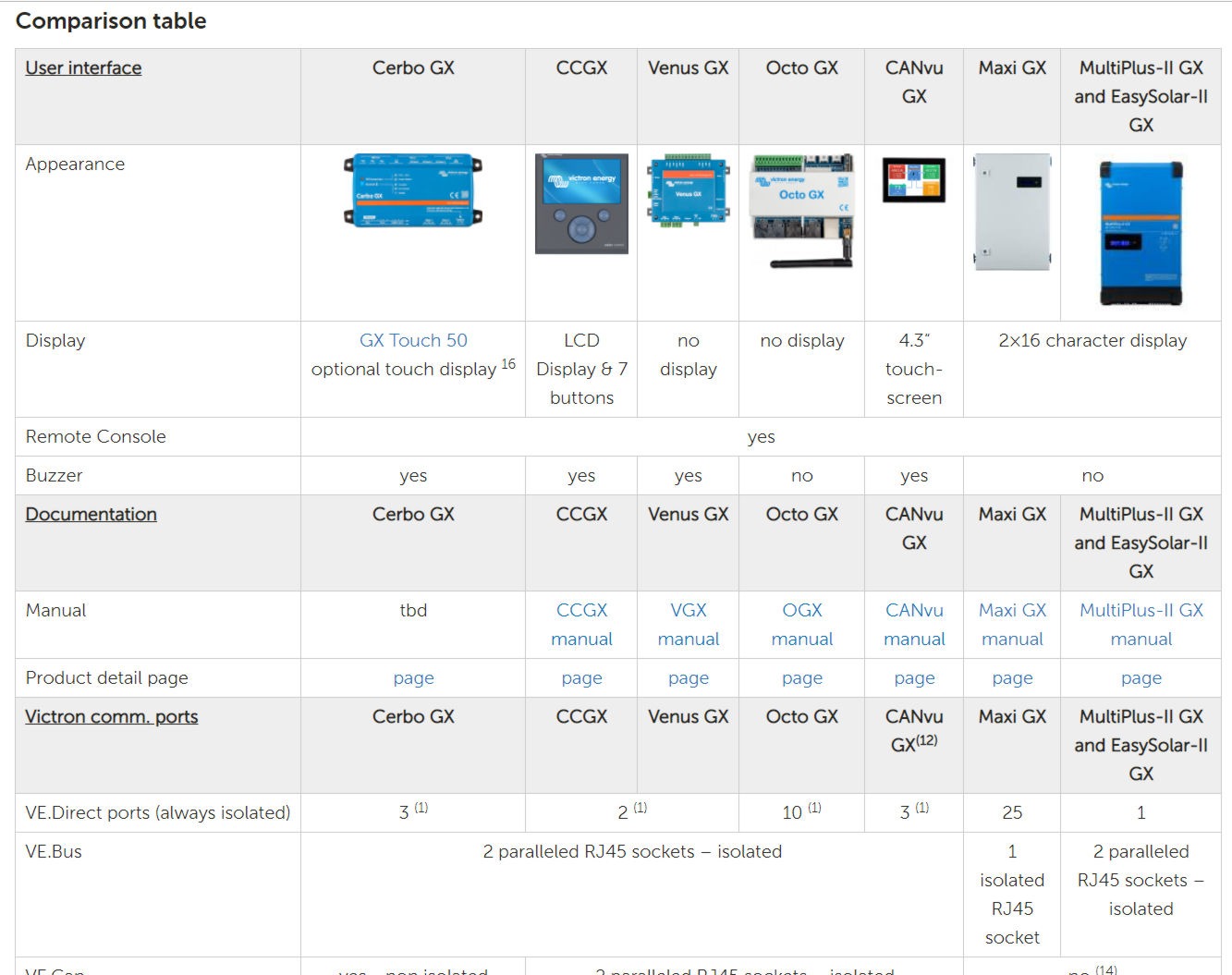
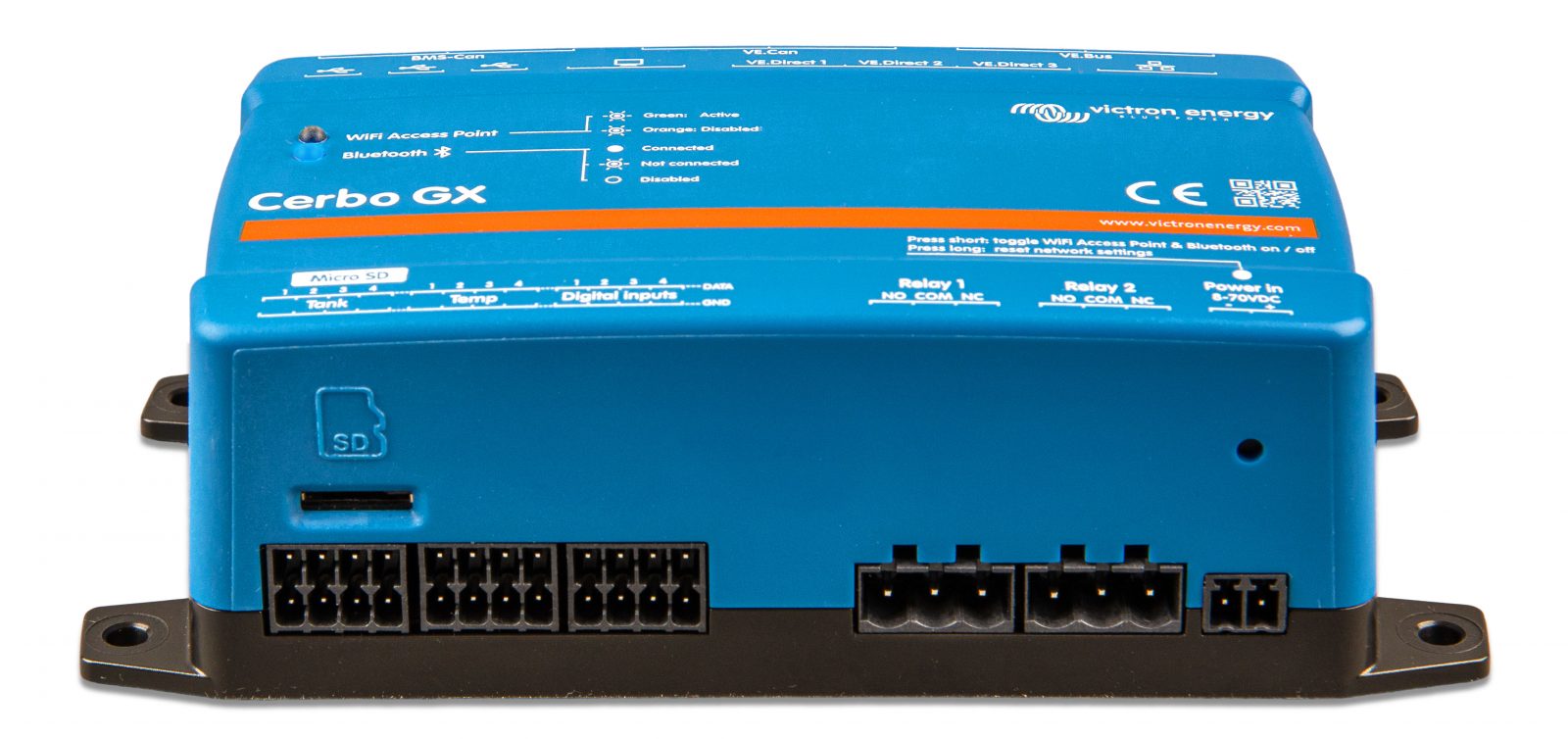
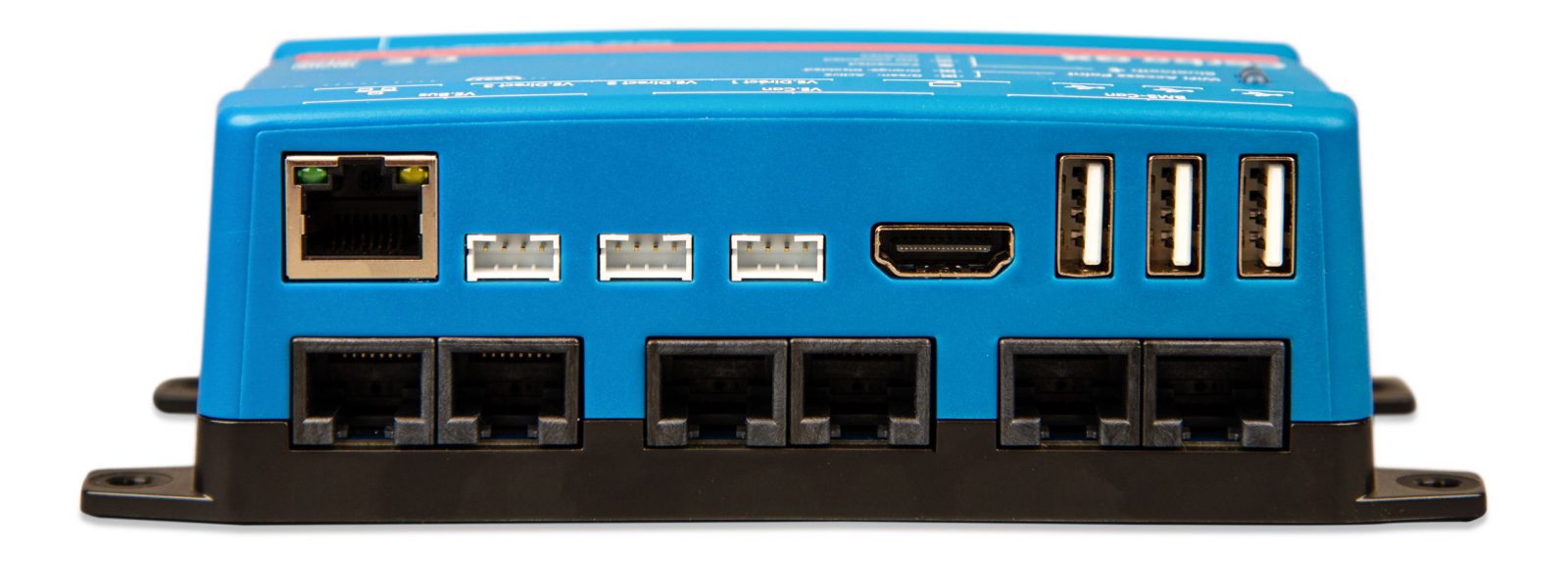

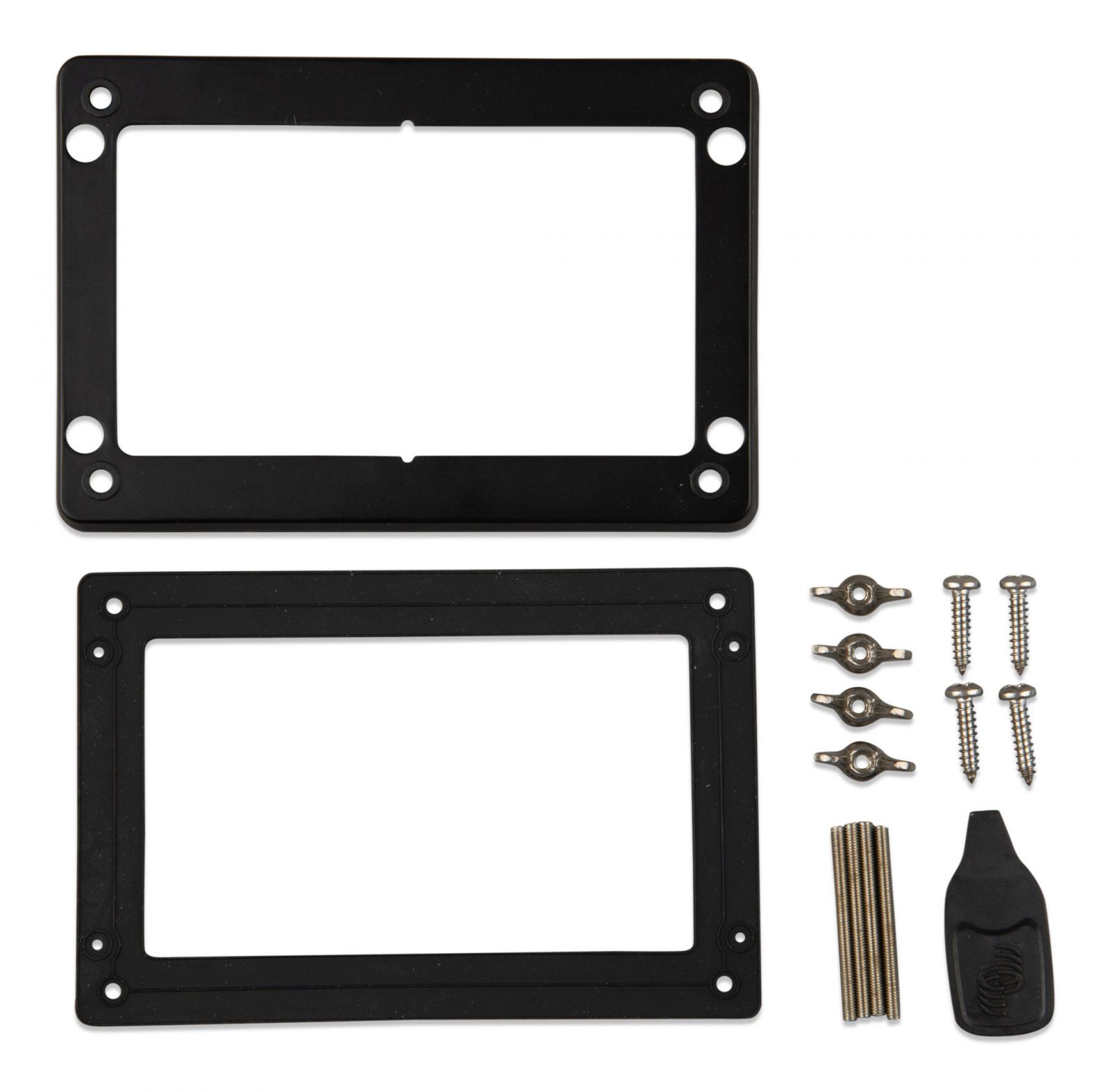

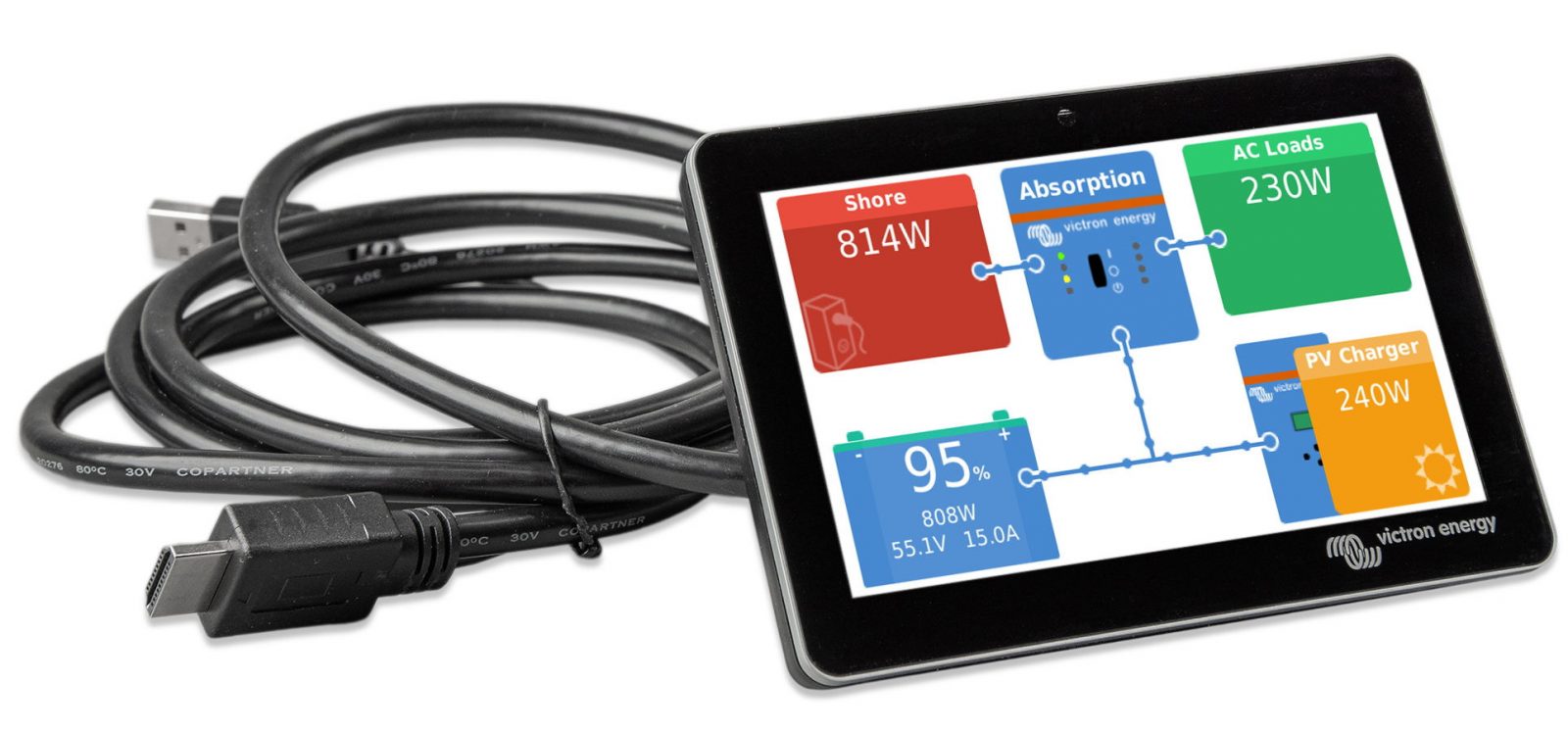
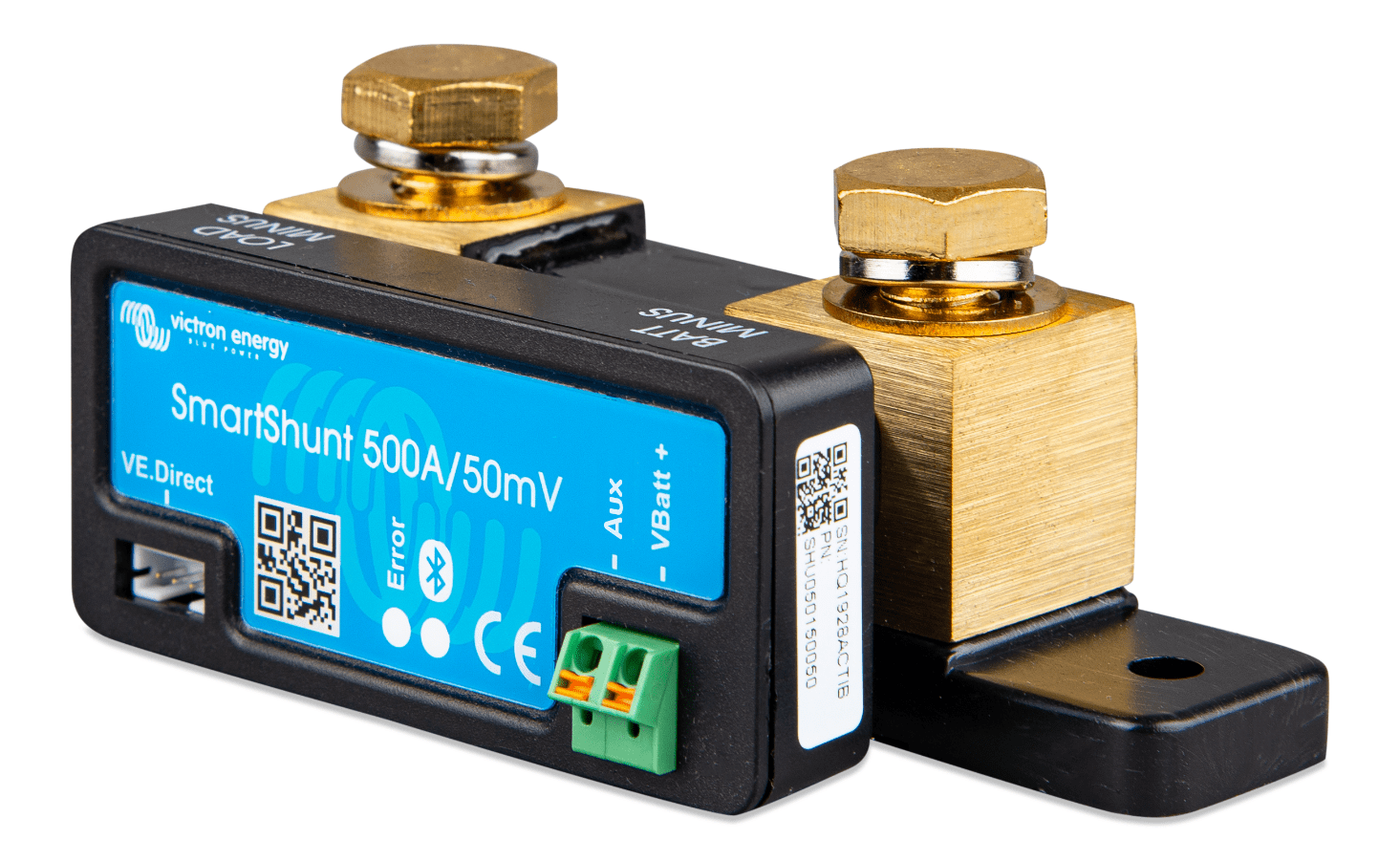











The installation simplicity of the new SmartShunt shouldn’t be overlooked. All it takes is getting the shunt between the first negative distribution and the battery and then connecting a source of 12v positive (probably the battery the shunt is going to be right next to) and you’re off. From there, fire up VictronConnect and configure the shunt. As Ben said, at that point you’ve got a fully functioning battery monitoring system and the option to connect it a myriad of display and management products from Victron.
Victron has been doing everything right for the last few years – adding more and more connectivity options, devices that people need, and ways to combine and configure them that does not take a PhD. I love the direction they’re going with componentized bits that you can combine together as you want to make a full system.
I have a nice Victron system on my boat, and have been testing the CCGX to NMEA 2000 feature for a bit. This has been a long time coming, and it only reports battery info right now, which is a bit limiting given everything else the CCGX sees. I hope this will expand, perhaps with the new products above.
I just tried the Venus GX NMEA 2000 output today, and saw in Maretron N2KAnalyzer that it’s identified as coming from two devices, the Venus and also the attached BMV 712. The BMV is putting out house battery info — SoC, Current, Voltage, and Temp — which will be nice to have on the network. It’s also transmitting a Switch Status PGN, which may have to do with its relay status? Meanwhile, the Venus N2K device isn’t putting out any data PGNs, but seems ready to.
Are you running the beta firmware? 2.40…?
Yes, I’m pretty sure the latest, but can’t check remotely now because I shut everything down. Sounds Charger/Inverter info is coming soon (at least to the beta):
“Add NMEA2000 out function: transmit battery monitor out on the VE.Can/NMEA2000 network so it can be picked up by Marine MFDs. Currently it only transmits battery monitor data. Inverter/charger data will follow soon.”
Yes I saw that a couple of days ago on the Victron forums. Having the battery information is helpful, although I can get most of that through the Venus+SignalK plugin and then having SignalK spit it out onto NMEA 2000, but that is not native and requires more pieces. I always like simplified things.
Really looking forward to the inverter/charger data, though!
Last line on the METS list of bullets: “Works with most MDF brands”. Ouch.
Why the Ouch, Keith? MFD integration works with current Garmin, Navico (Simrad, B&G, Lowrance), and Raymarine MFDs, with Furuno in the works
https://www.victronenergy.com/live/ccgx:start#marine_mfd_glass_bridge_integration
Maybe he’s commenting on the typo that transmogrified MFD into “MDF” 🙂
Dang, and I thought I had good eye for typos. Ouch!
Yes – it was the typo! I upgraded my Axioms to “Cannes” (November) and see the Victron app. I’m ready to buy the Cerbo GX as soon as it’s available – that will be my first piece of Victron gear.
Cool! NMEA 2000 output is now official in GX update 2.40 and it includes charger/inverter information as well as battery bank monitoring:
https://www.victronenergy.com/blog/2019/12/11/venus-os-v2-40-nmea2000-out-solar-irradiance-and-more/
I had a conversation with a Victron fellow at a recent SSCA Gam, and he alluded to what I think must be the Smartshunt device.
I’d really like to see Victron GX supporting multiple shunts, but I’m not sure that’s the intention with their SmartShunts. Also, I think that the Bluetooth will be strictly app to shunt, and mainly for configuration, while the V.E. Direct port will connect to a GX device (like the “Smart” solar controllers).
Meanwhile, the Simarine Pico can already handle many shunts though they have stopped talking about the NMEA 2000 integration that was supposed to come out in late 2017.
https://panbo.com/simarine-pico-good-ideas-in-battery-monitoring-more/
Agreed; I had all but decided on the Simarine Pico for my main RV monitoring (battery and charging status, tanks) with Victron on the power side (inverter/charger/MPPT) until I saw the Cerbo GX and GX Touch 50. The Cerbo GX/GX Touch 50 seems SO CLOSE to the holy grail; yet without discrete load monitoring, it gives up something to the Simarine.
I wonder if Victron have any interest in energy monitoring a la Sense, or at least with major loads like A/C, refrigerator, etc.
David, that’s an excellent question I can’t answer well. But the Victron SmartShunt is a real shipping product now…
https://www.victronenergy.com/battery-monitors/smart-battery-shunt
… and Ben Stein has already installed one on his new RV, write up coming soon.
The SmartShunt seems currently meant as a main battery bank shunt, but it does integrate with the Cerbo / GX family and I know one Victron employee who’s very hopeful that it or a related model will be developed for discrete load monitoring.
Ben, I did a small current test SmartShunt and I have a short film.
https://www.youtube.com/watch?v=myA5lqyFnQI
For 2 weeks I have been working on my boat on the N2K network with BMV 712 and other Victron devices such as BlueSolar MPPT, data is displayed on Garmin 8400 series devices and Maretron and Victron VRM.
Thanks, Christopher! Looks like you established that it’s quite accurate even at very small loads. Nice.
The BIG advantage of these management devices are the digital inputs. I have connected them to my bilge pumps, and now I get an email from the Victron VRM site when any of them are being used. And it is FREE, it saved me the monthly fees all these other monitoring systems charge. It paid for the Venus in a year !!
I like to think that it makes great sense for the Cerbo GX and the GX Touch 50 to be awarded a Pittman…
https://www.sailmagazine.com/gear/sail-magazine-2020-pittman-innovation-awards
… and am also happy to report that preorders will start soon with shipping expected in late March.
Great to see that Cerbo is now officially released, manual included:
https://www.victronenergy.com/panel-systems-remote-monitoring/cerbo-gx#downloads
And very nice that the Victron Blog entry about it makes good use of Panbo 😉
https://www.victronenergy.com/blog/2020/02/06/cerbo-gx-now-on-e-order-and-ready-for-pre-order/
Any indication on timing and price of the SmartShunt? I am doing a complete refit of my electrical and would like to use the SmartShunt and Cerbo GX with the touch to replace the BMV-712.
Call Peter Kennedy..he can tell you 1 410 280 2267
Or call Justin the US Manager. 1 207 3540493
Very cool! My free VRM monitoring site opened up this morning with a much improved power data dashboard presentation. You can see it too…
https://vrm.victronenergy.com/installation/30059/share/d9560ba7
… and, yes, Gizmo refrigeration and gadget loads are outpacing the solar panels, but I’m getting underway soon and a big burst of engine alternator power should show by this evening (though that’s the one major component VRM can’t specifically identify).
Can any of you folks who have a Cerbo tell me how much power it draws? The manual just tells me it has a 3 amp fuse :). If I get one, it will need to be on 24/7, and those amps add up.
I don’t have one but from the GX comparison table in the Victron GX product range document:
Cerbo GX power draw without GX Touch mounted: around 2.8W. With GX Touch 50 connected, and backlight off: 3.8W. Backlight at max intensity: 4.8W
Thanks, Howard! I wonder why they don’t put that info in the manual? But 2.8w isn’t bad at all – 200-240 ma I can live with 🙂
I’ve got one but it’s not with me. I seem to recall it draws a touch more than Howard mentioned per Victron’s specs. But, that was measured using a BMV and at that low of power consumption, I’m not sure the accuracy is too high. When I get back to Ft. Myers I’ll put it on a power meter and let you know exactly what I see.
-Ben S.
2 – 5 W for me
https://community.victronenergy.com/questions/42016/cerbo-gx-current-consumption.html
Ben and Jan, Thanks! The two fellows on that page who measured theirs were both running a cell device, so their numbers would be higher than what I’m planning on.
My concern is overnight with me aboard – no cell attachment or other fancy stuffe 🙂
I am curious if anyone has run out of the VE Direct ports and whether there is an alternative. I have 3 MPPT 100/30 units (3 solar arrays), the Smart Shunt, and just bought a Victron MultiPlus II. My goal is to wire up all 3 solar arrays as well as the smart shunt, but I will not have enough ports. Is there another port I should use? Ultimately, once fully integrated I hope to have all tanks monitors, bilge alarms and the Inverter/Charger.
Cam,
I wondered about the same thing. I have a bunch of the USB to VE.Direct cables on hand because I use them with Raspberry Pis. A while ago I tried using one of those with a Cerbo to see if one could expand the VE.Direct connectivity that way. Good news, it works! There are only two USB ports on a Cerbo GX that are general purpose, but I think you could use a USB hub to expand past that limit. I’m not sure if there’s a software limit about how many USB VE.Direct cables are supported, but I also think there’s likely to be a limit at some point as to how many we will really need.
-Ben S.
I think that the information available through the USB is more limited than through the VE. Direct
Cameron,
I haven’t seen any difference with the information gathered using a VE.Direct to VE.Direct cable than I have with a VE.Direct to USB cable (https://www.victronenergy.com/accessories/ve-direct-to-usb-interface). My Venus and VRM install on my RV (https://panbo.com/victrons-venus-os-on-a-raspberry-pi-install-and-configuration/) is via VE.Direct to USB cables since the Raspberry Pi doesn’t have any VE.Direct ports. I’ve run the same equipment on my test bench with a Cerbo and its built-in VE.Direct ports and I get the exact same data and control via either method.
-Ben S.
yes I have ve.direct to USB…then a bunch 5 in a USB hub then a long long long usb cable to the Venus and to the Gerbo..works like a charm
As input for the Gerbo/Venus I use a small relay which is triggered by the 24V for the bilge pump and the output makes a connection the ground pin of the digital input..so have 5 digital inputs there
Now Victron is also slowly moving forward with a 2nd OS for the Gerbo/Venus. which integrates with Signal K and with Node RED, creating many many options to integrate.
I do have to compliment Victron, they are the ONLY one making their management system online available fro free. Think the savings you get for JUST the bilge alerts!
Cerbo GX Max. VE.Direct devices /USB 15
https://www.victronenergy.com/live/venus-os:start?_ga=2.240535616.214232388.1632243075-459635056.1575670683
I recently installed a Cerbo GX partially based on this review. I’m loving all the data that is reported. I’d like to connect my 24v bilge pumps to the Digital inputs but the Cerbo manual isn’t too clear on how these should be connected. I’ve searched the web but haven’t come up with anything. Can anyone share how they’ve wired their bilge pumps to the Cerbo?
Hi William, I just configured my boat’s four Weema resistance-based tank senders to Cerbo, and everything worked quite well. But the Digital inputs seem a lot more complicated. They are not isolated and they expect 3.3v signals, 5v max.
https://www.victronenergy.com/media/pg/Cerbo_GX/en/digital-inputs.html
So apparently a “potential free relay or otherwise open collector/optocoupler” has to be wired in between 12 or 24v circuits like your bilge pump and the Cerbo digital inputs. I don’t know how to do that myself, but some users on Victron Community report success.
https://community.victronenergy.com/index.html
William
A long time ago I also went the opt coupler way, and even had a small unit deigned to so so…but….
the digital inputs also work if you just connect them to grand ( the 5th pin)
so an easy solution is to get a din-rail relay..which can be 12 or 24 V connected to what you want to monitor and the output you connect to one of the digital pins and the ground..
I have them for my ‘automatic’ whale bilge pumps. the ones with the 3 wires. ( + – and test)
when the bilge turns on the test wire becomes also positive…so you connect that to the relay and the other to the boats ground…then when the Blige pump turns on, the relay will be closed
and that connects on of the digital inputs to ground. and voila ..a FREE world wide alert system. That feature alone pays for the Gerbo. 🙂
Thanks, Jan-Kees, but can you please explain a little more. I see that each Digital Input has a Plus and Minus pin. Are you saying that a connection between a Minus pin and boat/Cerbo ground activates the input, no Plus voltage needed?
Ben
YES
I started with a Venus…and there you only have one minus, so I had to jerry-rig 5 (minus) wires into one.
Luckily with the Gerbo that pain is removed…
so just grab a small wire. screw it in the Plus ….enable the alarm..and while looking on the display ….touch the minus with the other end of the wire…and you see….alert 🙂
Now I use din rail relais Wago 788-304 ( the 24V version)
so one one side I have the bilge alert (A1 = + A2 = -). and on the relais side I connect 11 to the plus and 14 to the minus. So when the bilge pump goes on…11 and 14 make contact and alert me..thousands of miles away from my boat. Thanks to the free VRM. I do sound like a broken record, but these alerts are paying for the Venus or Gerbo in a year !
Thanks! I’m beginning to understand 😉
https://www.wago.com/us/relays-optocouplers/relay-module/p/788-303
you have my email…you can always call me 🙂
Jan-Kees, thanks very much for the input. I’ll be ordering the relays and connecting. As said the Cerbo is well worth the cost considering the versatility.
Jan-Kees, I installed the relay and the bilge pumps are being monitored. I’ve set an alarm to notify me if the pumps stay on for 60 consecutive seconds as this indicates an air lock or a flooding issue. I’d also like to set an alarm if the bilge cycles more than 15 times in a 24 hour period, however, the Victron cycle count is cumulative and doesn’t zero out once per day. Do you know a way to zero out the cycle count parameter?
NO not at this moment….
The only way to reset the cycle count is to change that digital input to some other setting and then restore it.
Here is a method where a person added a reset button, and you wil have to add the code to do so every 24 hrs. but it is not standard.
https://community.victronenergy.com/questions/70207/digital-input-count-clearreset-in-vrm-summary-page.html
Most likely it could happen in the future when more of the NODE RED will become available with the Venus OS Large
https://www.victronenergy.com/live/venus-os:large
I had it installed but have not had enough time to play with it, but it opens up a lot more options to automate and control other things.
Jan-Kees, ok thanks, yes I saw that posting on the Victron forum but figured that wasn’t a good option as it’s unlikely I’ll remember to reset daily. Hopefully Victron will add this ability in a future firmware update. For the time being I’m trying to configure grafana to give me the “first” and “last” data point in a time series so I can monitor the bilge cycle counts in a given time period but having difficulty getting it configured properly. If Victron builds in the reset it would make alarming much easier.